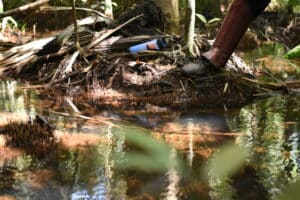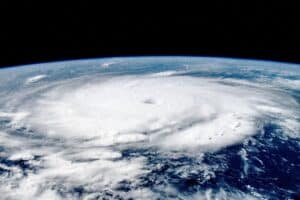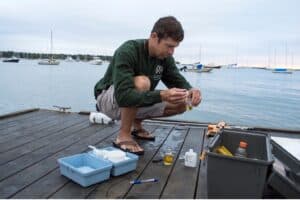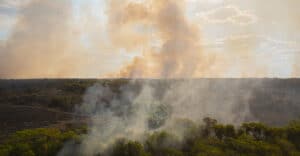Offsetting carbon alone won’t hold water

As I look out over the river from a floating cabin at the Mamirauá Sustainable Development Reserve in central Amazonia, it’s hard to imagine that water could become an issue here. It is the end of the rainy season and river levels, as usual, have peaked at 9-12 meters above their dry season mean. To my delight, we took canoes for a “hike” on the forest trails and spotted large fish like tambaqui and pirarucu , temporarily released from the confines of the riverbanks. The riverside communities we visit are practiced in dealing with these large seasonal fluctuations, having built their houses on stilts high on the riverbank and using boats to negotiate the ebbs and flows of the river, which they rely on for their livelihoods and transportation.
Climate change was the center of the debate between rural producers, scientists, public authorities and indigenous peoples at the Symposium to Celebrate the 20th anniversary of the Tanguro Research Station, which took place in Brasilia from June 10 to 12. The event highlighted the dialogue between the groups as a key to socio-environmental and economic transformation in favor of a possible future for life on Earth.
Functioning as an open-air laboratory, the Tanguro Research Station is located in the city of Querência, in Mato Grosso, in the southeastern Amazon. It was founded by IPAM (Amazon Environmental Research Institute) in partnership with the company Amaggi and the Woodwell Climate Research Center in the United States. In two decades of existence, the results of this joint initiative add up to more than 180 high-impact scientific publications and bring together researchers from seven countries studying the environment and agriculture.
Ângela Conceição, president of FETAGRI, speaks on a panel at the event (Photo: Lucas Guaraldo/IPAM)
‘’The revolution in the countryside cost almost 50% of the Cerrado and 20% of the Amazon, this model is no longer sustainable, “said André Guimarães, executive director of IPAM. “It is necessary to ask questions to companies, as they will also have to adapt services to a new climatic condition,” he added. The director recalled that the assumption of the work at the Tanguro Research Station is to bring agricultural production closer to nature conservation.
The plurality of experiences and knowledge shared at the symposium was highlighted by Max Holmes, CEO of the Woodwell Climate Research Center, an institution that has been working alongside IPAM for thirty years.
“Bringing together this group of experts from science, civil society and from different places gives me hope and optimism. The challenge for all of us is to take forward the big ideas around the climate solutions discussed. Climate conferences are opportunities to continue to make progress on these incredibly urgent issues, which can only be solved in partnership,” Holmes said.
Balance
The meeting of different sectors around the socio-environmental and economic discussion comes at a time when studies show the loss of natural functions of tropical forests due to the global burning of fossil fuels, and, in Brazil, mainly due to deforestation, degradation and fire.
Ecosystem services, as the benefits produced by nature are called, maintain all forms of life, ensuring air quality and the availability of water and food, for example. They contribute to pollination, pest control and local climate regulation, providing adequate rain, humidity and temperature for agricultural production.
“How do we build a land use solution so that people understand that it is possible to reconcile forest with conservation, development with job and income generation from a better use of what we have already cut down? This is Brazil’s challenge. That is why we have sought a partnership with IPAM. That is why we created, in the State of Pará, the State Policy on Climate Change and the Amazon Now program,” said Helder Barbalho, governor of the State of Pará, present at the event.
Pará Governor HelderBarbalho and Minister Paulo Teixeira participated in the symposium (Photo: Disclosure/Agência Pará)
“We don’t know what the world will be like going forward, we just know it can’t be the same. We have a lot to learn and build with each other. Climate change is real and the producer realizes it, but if he does not feel he belongs in the conversation about what needs to be improved, it is difficult to engage,” said Juliana Lopes, director of ESG, Communication and Compliance at AMAGGI.
From 2022 to 2023, agriculture grew by 15.1%, influencing GDP performance, but still putting pressure on Brazilian biomes. The Tanguro Research Station develops studies to understand the influence of the forest on agriculture and vice versa, in order to subsidize environmentally and socially sustainable production and conservation strategies.
“Results of Tanguro’s research socialized with us are important to see new perspectives and develop agriculture, ensuring food security,” added ÂngelaConceição, president of FETAGRI (Federation of Agricultural Workers of the State of Pará).
Juliana Lopes endorsed the recognition: “The partnership with IPAM was the way that AMAGGI found, with researchers, to make an assessment of how we can ensure continuity in agricultural production, investing in the conservation of biodiversity and native areas.”
Knowledge generation
Storing half the carbon emitted on the globe, tropical forests provide climate stability. This stockpile capacity is being hampered by climate change caused by human activities. “Our challenge is to find ways to maintain that service and, at the same time, growth and prosperity,” said Woodwell Climate Research Center researcher Michael Coe.
And how to find an answer to this challenge? The solution may lie in nature itself. Data presented by Wayne Walker, senior scientist at Woodwell, shows that nature-based solutions have the potential to deliver 37% of the emissions reduction needed to limit global average temperature rise to less than 2°C. “Land is more than just a carbon store. We need to implement these solutions in a scalable way, ensuring capital flows with equity and sustainability,” he commented.
IPAM researcher Filipe Arruda pointed out that environmental disturbances have been occurring more intensely with climate change. “The impact on the habitat modifies the animal and plant species on site, changing everything from temperature control to pest control within the forest and in agricultural areas.”
Leonardo Maracahipes, coordinator of the Tanguro Research Station and researcher at IPAM, presented a study on the change in tree leaves in areas of intact forest and in those fragmented by agricultural activity. “The thickness of the leaf was greater in the area of agriculture, while the size of the leaf was greater in the areas of preserved forest,” he explained, demonstrating vegetation strategies to adapt to the surroundings.
In farming, the effects of nature are also the object of study: “We estimate a 6% reduction in soybean yield for every 1°C increase in temperature,” said Ludmila Rattis, a researcher at IPAM and the Woodwell Climate Research Center. On the positive side, when the forest is maintained, it helps in production. Bianca Rebelatto, a researcher at IPAM, recalled that 90% of Brazil’s agriculture is not irrigated and that forests protect crops against heat waves and reduce future climate challenges.
Scientists working at the Tanguro Research Station (Photo: Mitch Korolev/Woodwell)
Responses presented by the sectors to avoid more extreme events, reducing damage to the environment and promoting responsible ways of living include, in addition to sustainable production, the bioeconomy of natural products from the Amazon and Cerrado.
“Land use change and climate change have already increased the chances of a catastrophic fire in the Xingu by another 10%,” explained Paulo Brando, IPAM associate researcher and professor at Yale University in the United States. “About 16% of forests in the southeastern Amazon may burn due to these factors. Fire-degraded forests seem healthy from the point of view of remote sensing, but they are much more vulnerable to extreme events such as drought, which is what is happening in the Xingu and much of the region.”
According to Brando, the Xingu region is 2°C warmer due to increased deforestation and human pressure on the natural landscape. The Xingu Indigenous Territory functions as a local air conditioner, with 5°C less than monocultures and neighboring pastures, revealed a technical note produced by IPAM and the Woodwell Climate Research Center.
While the situation is not resolved, the peoples of the Xingu continue to struggle to produce. “We have the land, but we keep buying in the city. We, from the Xingu, are still studying how we can make production on a larger scale, “said Yuri Kuikuro, a master’s student in Ecology at INPA (National Institute for Amazonian Research). “It is necessary to bring young people to train, to use technology, to try to understand how to produce to maintain our culture. Add science to figure it out,” he concluded.
Survival
“First we have to think about surviving climate change: working in the collective, regardless of whether it is civil society, company or public power, for our physical and mental survival,” said Mauro O’ de Almeida, Secretary of State for Environment and Sustainability of Pará, present at the symposium.
The climate emergency alerts to the Amazon’s point of no return, also known as the tipping point, from which the biome would lose its natural capabilities and become a type of degraded ecosystem — a “zombie Amazon”. In the Cerrado, the reality also worries scientists, given that most of the biome’s remaining native vegetation is within private rural properties.
“It is common to hear that the world will end, but it has already ended, due to climate change, for the people who died in Rio Grande do Sul,” said researcher Ludmila Rattis, referring to the extreme climatic event of rainfall in Rio Grande do Sul this year. About 175 people died and 38 are missing. More than 2 million were affected by the floods, according to the Civil Defense.
In the Amazon, the Rio Negro drought in 2023 affected all 62 cities in the State of Amazonas and affected more than 600,000 people, also according to the state Civil Defense.
“The Xingu Indigenous Territory is also being impacted by climate change. Indigenous people have been talking about this for a long time and we are not taken seriously. These extreme events are affecting all sectors, so sitting at the table with partners who were once our enemies shows how we need to be united to change the scenario we have, “said Kaianaku Kamaiurá, partnership coordinator at OURS and coordinator of the Amazônia de Pé project.
The climate commitments of Brazil and the world, to be renewed and expanded until COP30 (United Nations Conference on Climate Change) in Belém, are the necessary measure to prevent the worsening of housing conditions on the planet and prevent more lives from being lost.
“First, that the world can accelerate the change in the energy matrix to stop emitting carbon dioxide. Second, pay for the maintenance of the forest and its recovery. In the past, I remember that agribusiness was against the climate debate, but not today: it has assumed an awareness that it needs the forest. COP30 will be the great political space in the Amazon to demand from the world attention for those who are preserving,” said Paulo Teixeira, Minister of Agrarian Development and Family Agriculture.
The Tanguro Research Station 20-Year Celebration Symposium was held by IPAM in partnership with the Woodwell Climate Research Center, Yale University School of the Environment, and Max-Planck-Geselschaft. Learn more about the Tanguro Research Station and how to donate on the website.
Hurricane Beryl may be a stark preview of what’s to come
The monster storm is a history-maker, fueled by extremely high ocean heat and proving the Atlantic season is off to an extremely active start

Hurricane Beryl’s rapid evolution from a tropical depression to a major Category 5 threat so early in the summer is raising alarms that forecasts for a “hyperactive” Atlantic storm season might be on target.
Late Monday, the churning Beryl escalated to Category 5 intensity, packing maximum sustained winds of 165 miles per hour — unprecedented this early in the Atlantic season, according to the National Hurricane Center. It became the strongest July Atlantic hurricane on record, surpassing the 160-mile-per-hour maximum winds set by Hurricane Emily in 2005. Before Emily, Hurricane Allen in August 1980 held the record for the earliest Atlantic hurricane clocking 165-mile-per-hour winds.
Read more on The Boston Globe.
New water quality technology makes its debut in Buzzards Bay

Baywatcher sampling titrating dissolved oxygen
Every five days, Lisa Kingston, a 62-year-old critical care nurse, drives to the Onset pier to collect samples in the murky waters of Buzzards Bay.
“This is our oxygen bottle and this is our salinity bottle. We pull this — bloop, bloop, bloop, bloop, bloop —” she says, imitating the sound of water, “and that fills up.”
At the end of this dock, Kingston performs an hour-and-a-half-long data collection routine — just as she has done 22 times a summer for the past two years. She and fellow volunteer Susan Scott are here to take measurements on oxygen, water temperature, salinity, and more. Scott, a 77-year-old retired arts administrator, rips open a reagent packet and adds it to a glass vial.
2024 Switzer Fellowships awarded to environmental change-makers
Twenty environmental leaders have been chosen as 2024 recipients of the Switzer Environmental Fellowship, a program of the Robert and Patricia Switzer Foundation that awards graduate students a $17,000 cash award and leadership training to support their education and career development at 12 universities in New England and California. The 20 fellowships total $340,000 in awards.
During their fellowship year, Switzer Fellows cultivate their personal leadership skills toward advancing social equity, build relationships, and expand their networks through shared learning and professional development activities. Switzer Fellows receive support throughout their careers to pursue interdisciplinary and collaborative work, positioning them for leadership in the nonprofit, government, philanthropic, private, and academic sectors. The competitive fellowships are awarded based on leadership potential and commitment to environmental problem-solving. Switzer Fellows demonstrate innovation and collaboration, as well as commitment to advance social equity as a fundamental part of their environmental work. The 2024 Switzer Fellows join a network of over 750 Switzer Fellows working across the United States and around the world.
“The Switzer Foundation believes that talented and committed individuals can make change in the world, and we invest in supporting their continued leadership and professional development,” says Executive Director, Sarah Reed. “As lifelong members of the Switzer Network, the new fellows will be able to increase their impact as environmental leaders through shared learning, collaboration, and mutual support. We are thrilled to welcome these environmental and social change-makers to our community as 2024 Switzer Fellows.”
Robert and Patricia Switzer established the foundation with a belief in the power of individuals to make positive change in the world, and to support and encourage people dedicated to solving applied environmental problems. The 2024 Switzer Fellows come from diverse social, academic, and economic backgrounds and bring an impressive breadth of expertise on topics including agriculture, agroecology, avian ecology, environmental justice, environmental policy, environmental remediation, food systems & access, forestry, holistic land management, housing decarbonization, public health, renewable energy, tribal sovereignty, and urban planning. More information about the 2024 Switzer Fellows, and links to their profiles, is available on the Founation website.
The Robert and Patricia Switzer Foundation identifies and nurtures environmental leaders to create positive environmental change. The foundation awards academic fellowships and project grants, sponsors professional development activities, and fosters a vibrant network of more than 700 Switzer Fellows who are environmental and social change leaders working across academia, non-profits, government, philanthropy, and the private sector. For more information, see their website.
Fire bans not effective as the Amazon and Pantanal burn, study says

In August 2019, the number of fires in the Brazilian Amazon skyrocketed, making international headlines and prompting protests in cities like London, Paris and Toronto. While the global community was shocked by images of burning trees and animals, in Brazil, the arrival of the smoke in the country’s business capital and largest city, São Paulo, made the urban population suddenly wake up to the problem.
The crisis also drew the attention of the scientific community, which has since invested more effort into creating tools and data to understand the dynamics of fire in the Amazon, a biome not naturally adapted to burning. “All this caused a stir among researchers, who began to ask themselves, ‘What is going on?’” Manoela Machado, a researcher with the Environmental Change Institute at the University of Oxford, told Mongabay.
George Woodwell, 95, influential ecologist on climate change, dies
The founder of the renowned Woods Hole Research Center in Massachusetts, he also helped shape U.S. policies on controlling toxic substances like DDT.

George M. Woodwell, the founder of the Woods Hole Research Center in Massachusetts and a renowned ecologist whose keen research and understanding of policy shaped how the United States controlled toxic substances and how the world confronted climate change, died on Tuesday at his home in Woods Hole, Mass. He was 95.
The research center, which Dr. Woodwell started in 1985 to study global climate change, and which was later renamed for him, announced his death in a statement.
During his long career, Dr. Woodwell repeatedly shined a light on how the byproducts of new technologies — devised to increase efficiency in the agriculture, forestry and energy industries — had endangered natural systems. His research provided early evidence of what he called “biotic impoverishment” — the steady weakening of plants, animals and ecosystems that are chronically exposed to synthetic pollutants.
Continue reading on The New York Times.
George Woodwell, leader in climate studies, dies at 95

In discussing his 2016 book, “A World to Live In,” George M. Woodwell saw possibility in the often bleak world of climate science.
“The only course at the moment is to make the transition from fossil fuels to renewable energy sources, a perfectly attractive and possible and financially attractive, lucrative transition,” he explained to Steve Curwood of the “Living on Earth” radio show. “It’s not a dream, but it is a dream world. It’s a world that everyone would like to live in, and it’s a clean world in which human rights are protected, the common property resources of air, water, and land are cherished and defended, and industries have a purpose, a primary purpose, which is the quality of the public realm.”
Known as an optimist and a visionary leader in the environmental sciences—one whose work not only advanced his own research in ecology and climate, but also launched an entirely new field of scientific discovery, George Masters Woodwell died at his home in Woods Hole on June 18. He was 95.
Read more on The Falmouth Enterprise.




